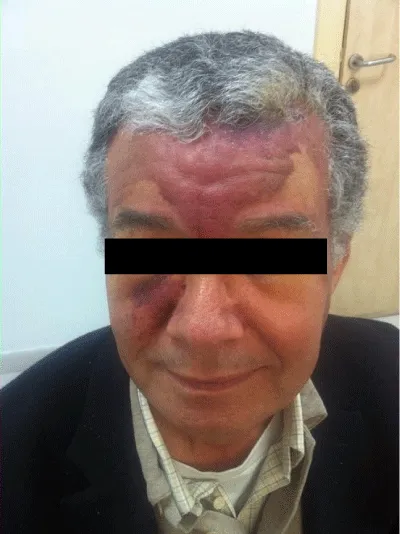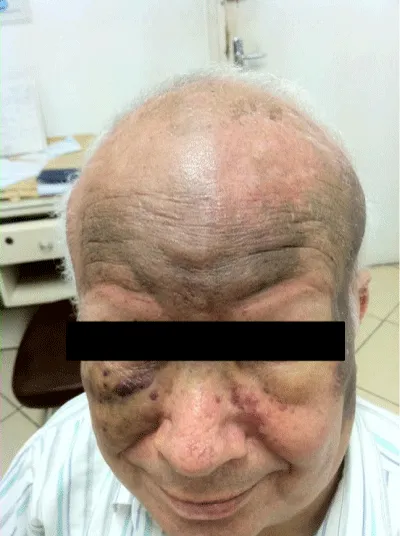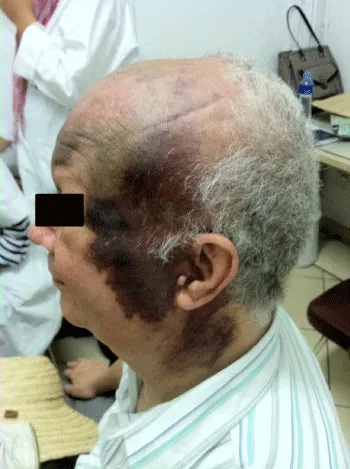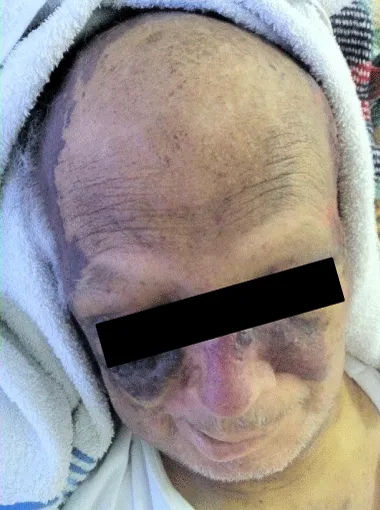Global Journal of Cancer Therapy
Angiosarcoma of the Scalp and Face: A Hard to Treat Tumor
Omar Jmour*, Lotfi Kochbati, Sahar Ghith and Farouk Benna
Cite this as
Jmour O, Kochbati L, Ghith S, Benna F (2017) Angiosarcoma of the Scalp and Face: A Hard to Treat Tumor. Glob J Cancer Ther 3(1): 026-029. DOI: 10.17352/gjct.000018Cutaneous angiosarcoma is a rare and aggressive malignant tumor of vascular origin. Multimodality treatment including surgery, radiotherapy and chemotherapy should be used according to age and local spread. Prognosis is poor with a 5-year survival of 10-15%. We report the case of an angiosarcoma of the scalp and face treated with sequential contact radiotherapy and chemotherapy. After local response, the patient progressed in non-irradiated zone then had liver metastasis.
Introduction
Angiosarcoma is a rare and aggressive malignant tumor of vascular origin. It represents 1 to 2% of soft tissue sarcomas and is most prevalent in elderly men. All areas of the body can be affected but most frequently the scalp and face [1,2]. The angiosarcoma may occur sporadically de-novo, following a treatment by radiotherapy or after chronic lymphedema as part of Stewart-Treves syndrome [3]. We hereby report the case of a patient with angiosarcoma of the scalp and face treated with contact radiotherapy and chemotherapy with local response and local progression in non-irradiated zone.
Observation
A 64-year-old man consulted before the rapid increase in the size of a centimeter plate of the scalp in an erythematosus and purplish closet, descending on the front, nose and eyelids Figure 1. Histological examination was in favor of an angiosarcoma of high-grade expressing the CD31. The extension work-up completed by a brain MRI and a thoraco-abdomino-pelvic scanner showed the absence of distant metastasis. After a multidisciplinary team meeting, a weekly paclitaxel-based chemotherapy was initiated, associated with palliative radiotherapy by contact (150Kv) issued at a dose of 40 Gy on the frontal lesion, which was the most extensive and the thickest. The evolution was marked by a net improvement of the irradiated lesion that has become depigmented and flat Figure 2. A local progression was observed for the other lesions that have afterwards been irradiated Figure 3. The patient progressed locally outside the treated fields Figure 4. Three months later, he consulted with dyspnea and a deteriorated general condition. The updating of the extension examination was in favor of multiple liver metastases and the presence of a pneumothorax that was drained in emergency. Before the metastatic dissemination and the bad general state, therapeutic abstention was retained. The patient died 15 days after leaving the hospital.
Commentaries
Cutaneous sarcomas are rare, representing only 5% of malignant tumors of skin [4]. The angiosarcoma constitute the fifth cause after Kaposi’s sarcoma, dermatofibrosarcoma protuberans, the histiocytofibrosarcoma and the leiomyosarcoma [5]. The sites of predilection of the cutaneous angiosarcoma are the head and neck, principally the scalp which is attained in nearly 40% of cases [6].
Heterogeneous symptoms, sometimes simulating benign lesions in type of bruising or hemangiomas can drag out the diagnosis and make any resection difficult, extensive and mutilating. Most angiosarcomas occur spontaneously but malignant transformations of benign vascular lesions have been described in the literature [7]. Several risk factors are associated with angiosarcomas. Chronic lymphoedema known as Stewart-Treves syndrome, arising after surgery, radiotherapy or as a part of Milroy’s disease is the most common one. The radiotherapy also constitutes an independent risk factor. Moreover, exposure to chemicals such as arsenic, vinyl chloride and thorium dioxide increases the risk of developing an angiosarcoma [3].
The role of immunosuppression in the pathogenesis of angiosarcomas is undetermined. Several cases following a renal transplant have been reported [8]. Goedert et al. suggested that similarly to Kaposi sarcoma, angiosarcoma and AIDS could be associated [9]. Although the role of Human Herpes Virus 8 (HHV8) in Kaposi sarcoma is proven, its involvement in the pathogenesis of angiosarcomas was not found [10].
The immunohistochemistry plays an important role in the diagnosis of the angiosarcoma and especially for those that are undifferentiated. Ulex lectin and CD31 are more sensitive and specific endothelial cell markers of skin angiosarcoma [11].
Angiosarcoma is an aggressive tumor, with extended skin dissemination, relapsing locally and giving early metastases through blood and/ or lymphatic. Metastases are most often of lung, bone, lymph node and liver. The lung is the most common site and the leading cause of death. In a Japanese autopsy serie of 95 patients [12], pulmonary metastases were found in nearly 70% of cases.
Besides, primary tumors located at the scalp level had a more frequent rate of pulmonary complications, type of pneumonia, pneumothorax and hemothorax, than the other locations [12]. In a more recent study of 37 cases, which focused only on angiosarcoma of the scalp and face, lung metastases occurred in 77% of patients [13].
The prognosis for cutaneous angiosarcoma of the scalp and face remains dark with 5-year survival rates in older series of 10-15% [1,2,14]. More recent studies, although retrospective, reported survival rates at 5 years from 38 to 54% thanks to improved techniques of radiotherapy and chemotherapy [15-18] Table 1. In addition, patients of less than 70 years, more inclined to tolerate a multimodal approach to their treatment (surgery, radiotherapy, chemotherapy), seem to have less local recurrence and better survival [6,18,19].
Surgical treatment remains the cornerstone of treatment even though obtaining a complete surgical excision is difficult in front of the local extent at the scalp and face area [20].
The use of radiation therapy associated to surgery allows a better local control of the disease [9,15,20,21]. Recommended doses appear to be 70 Gy or more in case of non-operated tumor (macroscopic disease) and 60 Gy or more in case of operated tumor (microscopic disease). Indeed, in the study of Ogawa et al. [13], 4 patients among 11 treated with radiotherapy with a dose of less than 70 Gy relapsed in the field of treatment while none of the 14 patients treated only with radiotherapy with a dose superior or equal to 70 Gy has relapsed in the treatment field. Regarding patients treated by surgery and radiotherapy, 2 patients among 6 treated with a dose of less than 60 Gy relapsed in the field of treatment whereas none of the patients among the 11 treated with a dose superior or equal to 60 Gy has relapsed in the treatment field. However, the recurrence of those outside the treated field still constitutes a problem. Our patient was treated by contact palliative radiotherapy (150Kv) and the response was good but transitional at low dose levels of 40Gy. The disease was spreading close to close on all the tegument of the face, making its coverage by fields and tolerable doses random. The use of new radiotherapy techniques including tomotherapy seems to offer promising results [22,23].
More recently, the taxane-based chemotherapy [24] and immune-therapy by recombinant interleukin 2, were added to the available therapeutic arsenal [18]. Isogai et al. [25] reported a case of complete remission of pulmonary metastases of an angiosarcoma of the scalp treated with docetaxel. Docetaxel and paclitaxel are effective options in the treatment of cutaneous metastatic angiosarcoma or locally advanced notably by their anti angiogenic effect [26-28]. In the Fata et al. [27], a response rate of 89% by paclitaxel for angiosarcoma of the scalp or face was noted.
However, a non-surgical approach remains possible for some patients particularly in locally advanced tumor. Fujisawa et al. [29] reported better 5 years overall survival for patients treated with taxane-radiotherapy compared to those treated with surgery and radiotherapy. In the study of Patel et al. [17], 2 non operated patients, receiving chemotherapy, respectively paclitaxel-bevacizumab and docetaxel-gemcitabine, associated with radiotherapy survived more than 3 years. Angiosarcoma is derived from vascular endothelial cells and overexpress VEGF and its receptors [3]. Biological therapies using tyrosine kinase inhibitors targeting VEGFR (sorafenib and sunitinib) and VEGF monoclonal antibody (bevacizumab) seem to offer interesting results [3].
The rarity of this pathology makes phase II/III studies difficult to undertake and the best therapeutic sequence between the different available methods involving surgery, radiotherapy, immunotherapy and chemotherapy, still need to be defined.
Conclusion
The angiosarcoma of the scalp and face is a rare pathology. Its local aggressiveness and its metastatic dissemination (notably at the pulmonary level) make a very bad prognosis tumor. The young age, the extent of the lesions and the quality of surgical excision are the main prognostic factors. A multimodal therapeutic approach seems to offer the best chances of patients’ survival.
- Hodgkinson DJ, Soule EH, Woods JE (1979) Cutaneous angiosarcoma of the head and neck. Cancer 44: 1106–1113. Link: https://goo.gl/H2Nej9
- Holden CA, Spittle MF, Jones EW (1987) Angiosarcoma of the face and scalp, prognosis and treatment. Cancer 59: 1046–1057. Link: https://goo.gl/UbZrNU
- Young RJ, Brown NJ, Reed MW, Hughes D, Woll PJ (2010) Angiosarcoma. Lancet Oncol 11: 983–991. Link: https://goo.gl/cqXlKG
- Costache M, Ene AM, Simionescu O, Sajin M (2010) Histopathological diagnosis of cutaneous vascular sarcomas. Rom J Morphol Embryol 51: 105–109. Link: https://goo.gl/37BjDZ
- Rouhani P, Fletcher CDM, Devesa SS, Toro JR (2008) Cutaneous soft tissue sarcoma incidence patterns in the U.S.: an analysis of 12,114 cases. Cancer 113: 616–627. Link: https://goo.gl/f5MdUl
- Albores-Saavedra J, Schwartz AM, Henson DE, Kostun L, Hart A, et al. (2011) Cutaneous angiosarcoma. Analysis of 434 cases from the Surveillance, Epidemiology, and End Results Program, 1973-2007. Ann Diagn Pathol 15: 93–97. Link: https://goo.gl/0Noa2v
- Rossi S, Fletcher CD (2002) Angiosarcoma arising in hemangioma/vascular malformation: report of four cases and review of the literature. Am J Surg Pathol 26: 1319-1329. Link: https://goo.gl/hZTB5R
- Ahmed I, Hamacher KL (2002) Angiosarcoma in a chronically immunosuppressed renal transplant recipient: report of a case and review of the literature. Am J Dermatopathol 24: 330-335. Link: https://goo.gl/m0sfSf
- Goedert JJ, Cote TR, Virgo P, Scoppa SM, Kingma DW, et al. (1998) Spectrum of AIDS-associated malignant disorders. Lancet 351: 1833-1839. Link: https://goo.gl/4MO8Oj
- Schmid H, Zietz C (2005) Human herpesvirus 8 and angiosarcoma: analysis of 40 cases and review of the literature. Pathology 37: 284-87. Link: https://goo.gl/acUfWJ
- Orchard GE, Zelger B, Jones EW, Jones RR (1996) An immunocytochemical assessment of 19 cases of cutaneous angiosarcoma. Histopathology 28: 235–240. Link: https://goo.gl/KD10dN
- Kitagawa M, Tanaka I, Takemura T, Matsubara O, Kasuga T (1987) Angiosarcoma of the scalp: Report of two cases with fatal pulmonary complications and a review of Japanese autopsy registry data. Virchows Arch A Pathol Anat Histopathol 412: 83–87. Link: https://goo.gl/5NROKA
- Ogawa K, Takahashi K, Asato Y, Yamamoto Y, Taira K, et al. (2012) Treatment and prognosis of angiosarcoma of the scalp and face: a retrospective analysis of 48 patients. Br J Radiol 85: e1127–e1133. Link: https://goo.gl/zD17Y4
- Mendenhall WM, Mendenhall CM, Werning JW, Reith JD, Mendenhall NP (2006) Cutaneous angiosarcoma. Am J Clin Oncol 29: 524–528. Link: https://goo.gl/96VISc
- Guadagnolo BA, Zagars GK, Araujo D, Ravi V, Shellenberger TD, et al. (2011) Outcomes after definitive treatment for cutaneous angiosarcoma of the face and scalp. Head Neck 33: 661–667. Link: https://goo.gl/cyLFbj
- Dettenborn T, Wermker K, Schulze H-J, Klein M, Schwipper V, Hallermann C (2014) Prognostic features in angiosarcoma of the head and neck: A retrospective monocenter study. J Cranio-Maxillofacial Surg 42: 1623–1628. Link: https://goo.gl/9wXUb2
- Patel SH, Hayden RE, Hinni ML, Wong WW, Foote RL, et al. (2015) Angiosarcoma of the scalp and face: the Mayo Clinic experience. JAMA Otolaryngol. Head Neck Surg 141: 335–340. Link: https://goo.gl/rB60x0
- Ohguri T, Imada H, Nomoto S, Yahara K, Hisaoka M, et al. (2005) Angiosarcoma of the scalp treated with curative radiotherapy plus recombinant interleukin-2 immunotherapy. Int J Radiat Oncol Biol Phys 61: 1446–1453. Link: https://goo.gl/DSWXqw
- Miki Y, Tada T, Kamo R, Hosono MN, Tamiya H, et al. (2013) Single institutional experience of the treatment of angiosarcoma of the face and scalp. Br J Radiol 86: 20130439. Link: https://goo.gl/3BfBgf
- Ward JR, Feigenberg SJ, Mendenhall NP, Marcus RB, Mendenhall WM (2003) Radiation therapy for angiosarcoma. Head Neck 25: 873-878. Link: https://goo.gl/8ja3lk
- Karasawa K, Kageyama S, KItou S, Shibata Y, Ito K, et al. (2014) IMRT for Angiosarcoma of the Scalp Using Tomotherapy: Planning Study and the Initial Results. Int. J. Radiat. Oncol. Link: https://goo.gl/6UCCkj
- Hauguel MC, Durand LJ, Girard E, Mirabel X, Templier C, et al. (2014) Efficacité de la tomothérapie chez une patiente présentant un angiosarcome du cuir chevelu. Ann. Dermatol. Venereol 141: 321-322. Link: https://goo.gl/kw3FZI
- Penel N, Lansiaux A, Adenis A (2007) Angiosarcomas and taxanes. Curr. Treat. Options Oncol 8: 428-434. Link: https://goo.gl/DrrYwR
- Isogai R, Kawada A, Aragane Y, Tezuka T (2004) Successful Treatment of Pulmonary Metastasis and Local Recurrence of Angiosarcoma with Docetaxel. J. Dermatol 31: 335-341. Link: https://goo.gl/Kzp4Zo
- Nagano T, Yamada Y, Ikeda T, Kanki H, Kamo T, et al. (2007) Docetaxel: a therapeutic option in the treatment of cutaneous angiosarcoma: report of 9 patients. Cancer 110: 648-651. Link: https://goo.gl/7tTcKq
- Fata F, O'Reilly E, Ilson D, Pfister D, Leffel D, et al. (1999) Paclitaxel in the treatment of patients with angiosarcoma of the scalp or face. Cancer 86: 2034-2037. Link: https://goo.gl/8Hhnku
- Penel N, Bui BN, Bay J-O, Cupissol D, Ray-Coquard I, et al. (2008) Phase II Trial of Weekly Paclitaxel for Unresectable Angiosarcoma: The ANGIOTAX Study. J. Clin. Oncol 26: 5269-5274. Link: https://goo.gl/Mjf4Rg
- Fujisawa Y, Yoshino K, Kadono T, Miyagawa T, Nakamura Y, et al. (2014) Chemoradiotherapy with taxane is superior to conventional surgery and radiotherapy in the management of cutaneous angiosarcoma: a multicentre, retrospective study. Br. J. Dermatol 17: 1493-500. Link: https://goo.gl/YZhq69
Article Alerts
Subscribe to our articles alerts and stay tuned.
 This work is licensed under a Creative Commons Attribution 4.0 International License.
This work is licensed under a Creative Commons Attribution 4.0 International License.





 Save to Mendeley
Save to Mendeley
